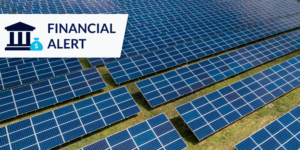
As the construction energy industry deals with a significant roadblock in the supply chain, many solar energy contractors are taking a hit.
Four renewable energy and solar contractors around the US ended up in bankruptcy proceedings within the span of just six days in October — signaling that current worldwide solar energy problems could have a serious short-term impact on small businesses.
October 14, 2021, saw bankruptcy petitions filed for South Carolina’s SunStore Solar, LLC and Washington State’s UniEnergy Technologies, LLC, while Texas’ Let’s Go Solar, LLC followed closely behind on October 15, 2021. Pennsylvania’s Coatesville Solar Initiative, LLC filed its petition just a few days later on October 20, 2021.
Despite the fact that the solar industry is seeing a boom — with renewable energy pledges and corporate commitments driving a period of major increased demand — supply chain shortages have put significant constraints on companies’ abilities to affordably maintain their standard operations, with shipping struggles, component shortages, and COVID-19 shutdowns putting pressure on companies.
Though these four companies are in different situations, the situation is especially difficult for three of them. SunStore Solar and Let’s Go Solar filed for voluntary Chapter 7 bankruptcy — a move that may result in the end of the companies’ operations — and UniEnergy Technologies was forced into proceedings through an involuntary Chapter 11 bankruptcy petition filed by a number of its creditors.
Coatesville Solar is in a slightly easier situation, as it’s filing for Chapter 11 bankruptcy, which allows for a debtor to reorganize its liabilities and restructure itself to continue operations.
On the other hand, Chapter 7 bankruptcy is often referred to as “liquidation” bankruptcy, as it doesn’t allow for a company to handle its debts with a reorganized payment plan like in Chapter 11. Instead, the debtor has to sell off its non-exempt property in order to pay its debts — a situation that often will result in loss of property and the end of a company’s operations.
Learn more about the types of bankruptcy chapters — and what they can mean for a construction business.
As in the case of UniEnergy Technologies, a group of petitioners can file to initiate an involuntary bankruptcy in order to secure the payment of the debtor’s liabilities.
Involuntary bankruptcies are rare in construction, but can be effective for creditors looking to receive payment. As construction lawyer Mazyar M. Hedayat notes, the process brings transparency to the table: “There is less opportunity for chicanery on the part of the Debtor, and Creditors can file claims to be reviewed by a neutral party.”
SunStore Solar cited $328,379.36 in liabilities in its proceedings, while Let’s Go Solar noted debts totaling $166,815.34 and Coatesville Solar is dealing with $956,204.43 in claims from its creditors.
UniEnergy Technologies’ involuntary petition was filed by five creditors claiming a total of $259,752.32, with the most significant amount being supplier Aggreko, LLC’s $146,370.51 claim.
Supply shortages are impacting solar just as heavily as other parts of the construction industry
Though the entire construction industry is dealing with heavy supply chain problems, contractors would be wise to keep an eye on the ways in which the solar industry is being affected and why some companies are having to enter bankruptcy proceedings. With demand driving up prices, a number of solar contractors are struggling to keep up supply — and paying far more to do so.
“In January, things were fine. By the end of March, it was ‘all hands on deck’ to make sure you’re supplied,” said Aric Saunders, executive vice president of battery company Electriq
Other major companies are impacting the way that the industry is shifting, as well. When one has supply problems, competitors that can provide get a major boost. Saunders mentioned that Tesla — which faces a backlog numbering in the tens of thousands for its Powerwall home battery, according to CEO Elon Musk — has inadvertently caused demand to rise for Electriq Power.
“Due to Tesla’s supply constraints, our demand is skyrocketing,” Saunders said. “People are looking for alternatives. They’re calling all the other options out there and finding quality choices.”
However, this doesn’t mean that supply is at healthy levels. “Everyone’s trying to grab batteries at the same time,” added Saunders. “The facilities aren’t ready for it. There are not enough manufacturing facilities to meet current demand for the Tier 1 batteries.”
Major worldwide producers of solar cells are also holding back production for various reasons. A number of customers are balking at the price increases caused by the rising prices needed to produce solar equipment; in turn, they’re reducing their demand, which is affecting output.
“We have to manufacture the product, but on the other hand, if the price is too high, the project developers want to wait,” noted Jack Xiao, marketing director at solar panel exporter BeyondSun Holdings.
There are those who feel like the situation is going to improve, however, citing aspects of the supply chain that haven’t yet been tapped into. “This feels like short-term business cycle anomalies,” said Jason Burwen, interim CEO of industry group US Energy Storage Association, describing the current scarcity. “I have no reason to believe this is secular and longer-term. You have so much new capacity committed to coming online.”
“We’re not seeing a shortage of supply industrywide; we’re really just seeing a shortage with Tier 1 vendors,” said Danny Lu, senior vice president of Powin Energy. “There are a lot of Tier 2 vendors or fringe-Tier 1 that have unsold capacity.”
What you need to know: How to Protect Your Payments During Construction Bankruptcy